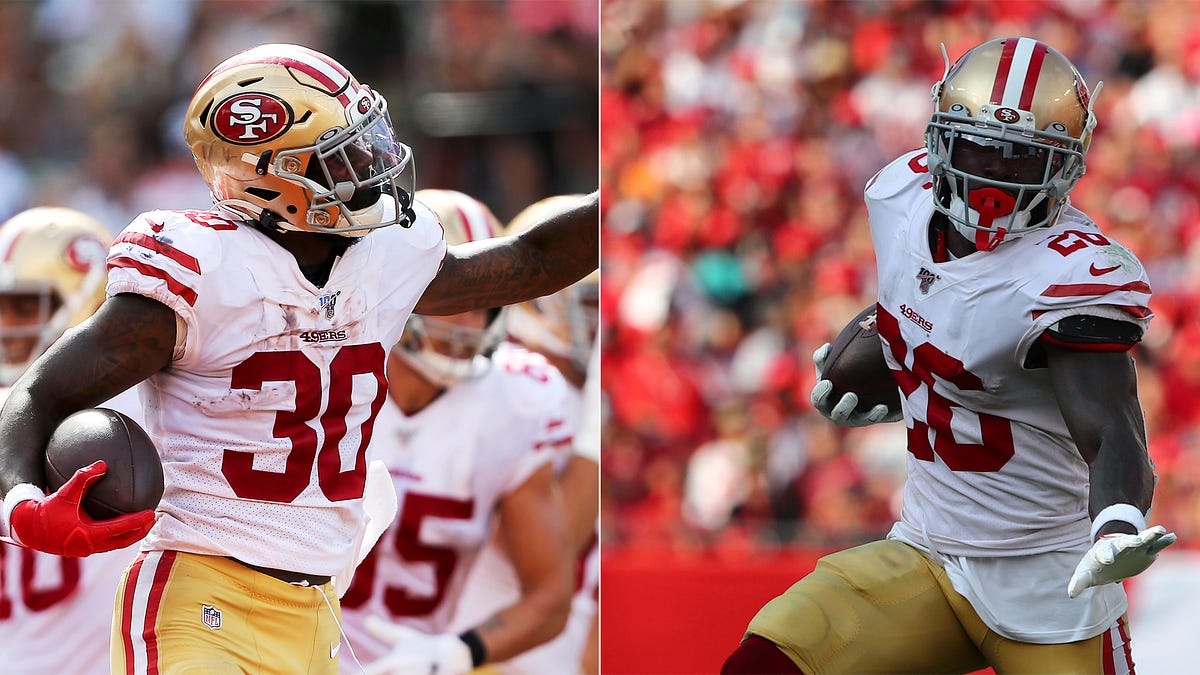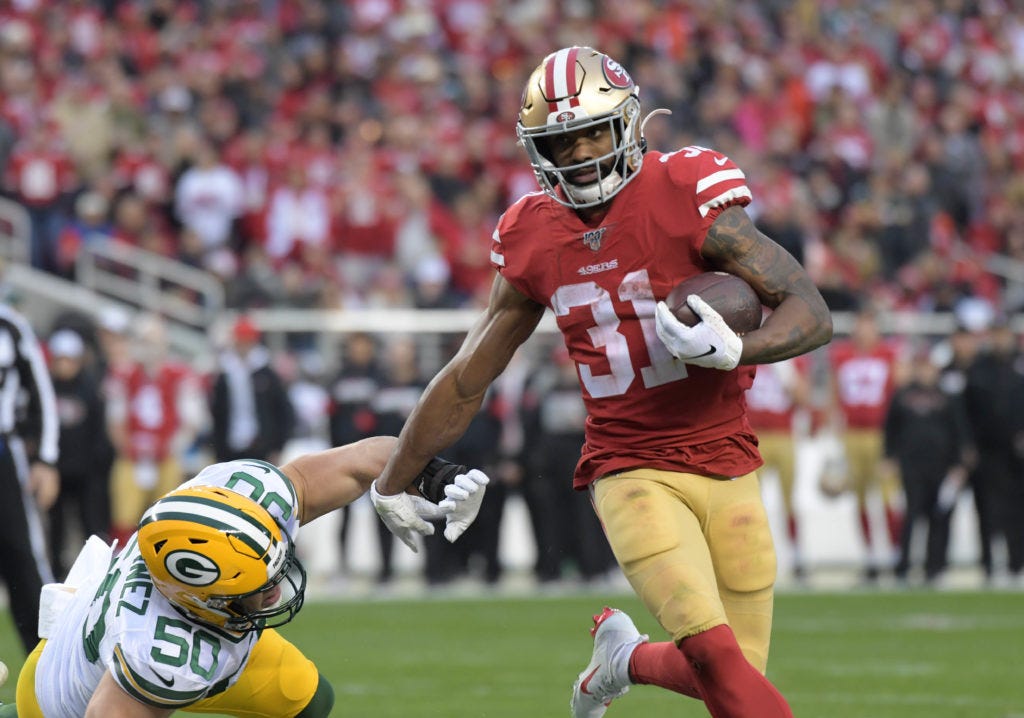Player Profile: Raheem Mostert

Finding a weapon at running back, particularly later in a draft, is a gold mine for fantasy owners. And that’s what makes today’s subject, Raheem Mostert, so fascinating. When last we saw Mostert, he was dominating in the playoffs as the 49ers advanced to the Super Bowl.
In three games in the post-season, Mostert rushed for 336 yards and five TDs for the 49ers, including 220 yards and four TDs in the NFC Championship Game against the Packers. And that came following a stout stretch to end the 2019 season. Mostert finished the 2019 season with 772 yards and eight touchdowns, doing most of that damage in the final five games he played in the season. His role as the seeming lead back for the 49ers attack to end the season and in the playoffs puts him in prime position heading into 2020.
And yet, questions abound. That’s clear when considering Mostert’s ADP, which currently sits as RB 29 in PPR and RB 25 in Standard, making him an RB3. But if he’s the player that ran for 220 yards and four TDs in the NFC Championship Game and added seven TDs in six games to close 2019, why so low — especially considering the 49ers are a run-first team?
This isn’t the first time Mostert has shown flashes, either. While he’s been on the 49ers since 2016, his first time to really show what he could do as a back came in 2018. During a stretch in the middle of the season, Mostert ran for 261 yards and averaged 7.68 yards per carry. That included going for 87 yards on 12 carries against the Green Bay Packers and 86 yards and a touchdown on seven carries in Week 9 against the Raiders. But it was a mostly forgettable season for the 49ers, and Mostert was lost in the shuffle heading into 2019. So is that the reason for guarded optimism in 2020? Let’s consider.
A Crowded Running Back Field

One of the reasons Mostert was lost in the shuffle to start 2019 was his competition. Prior to the 2018 season, the 49ers signed Jerrick McKinnon to a free agent deal. Prior to the 2019 season, they signed Tevin Coleman. In addition, they had Matt Breida and Jeff Wilson, both of whom showed flashes in 2018 alongside Mostert. And heading into 2020, while Mostert raised his profile with a post-season to remember, the crowd in San Francisco hasn’t gotten much smaller.
The 49ers did make one move in the backfield, sending Breida to the Dolphins for a fifth round pick. While that seems like a vote of confidence for Mostert, he’s still got plenty of competition. While McKinnon hasn’t played a down for the 49ers in the regular season thanks to injuries, he’s still there aiming to return to the field in 2020. So, too, is Coleman, who had his own moments of dominance in 2020 that were seemingly forgotten after that post-season run. And journeyman Wilson is still lurking, possibly the next back deep on the depth chart to vault to prominence. Setting Wilson aside for the moment, let’s consider the case for McKinnon and Coleman.
McKinnon has lost back-to-back seasons due to injury, so it’s easy to forget that the 49ers thought he would be the guy when they nabbed him in free agency prior to the 2018 season. At one time he signed a rich free-agent deal, but now the 28-year-old back is playing on what is essentially a one-year deal. That could add motivation to bounce back to form. And McKinnon showed that during his four years with the Vikings.
He rushed for 1,918 yards and seven TDs. But, better yet, he showed himself a capable receiver. In his final year with the Vikings in 2017, McKinnon drew 68 targets and turned that into 51 receptions for 421 yards and two TDs. And though he’s likely third in line for touches, his ADP of RB 79 in PPR and RB 90 in Standard could make him the best bargain.
The chief rival to Mostert in San Francisco is likely Coleman, who signed a two-year, $8.5 million deal prior to last season. So he is also in a contract year. Coleman had 544 rushing yards and six TDs last season, adding 21 receptions for 180 yards and a TD. That included his own bust out game in Week 8 against Carolina where Coleman rushed for 105 yards and three TDs, catching a fourth TD, and drawing references to Jerry Rice with a four-TD game. He also ran for 105 yards and two TDs in the 49ers first playoff game, a win over the Vikings. So while he was overshadowed down the stretch and in the playoffs, Coleman still figures to be a part of the 49ers Plans. And his ADP is RB 43 in PPR and RB 41 in Standard, making him a decent late round find as well.
Why Mostert?

Breida was the second-best RB performer on the 49ers in 2019. He rushed for 623 yards and touchdown, averaging 5.1 yards on his 123 carries. But he’s now out of the mix. Meanwhile Coleman and Mostert each got 137 carries, while Mostert had 5.6 yards per carry against Coleman’s 4.0. The difference is efficiency, and it’s quite possible Mostert fits this offense a little better.
I think Mostert and Coleman will split work — last year Coleman was the “starter” for 11 games and Brieda for five games — but there is plenty of work to go around. I like what I’ve seen on the field, and I think Mostert has some great upside. But what holds him back might be the receiving game. None of the 49ers’ backs was great last year, but Mostert added just 14 receptions for 180 yards and two TDs on 22 targets last year. If McKinnon finds a meaningful role in 2020, I think it’s possible it’s as a receiver.
If Mostert gets a bigger share of the rushing work in 2020, which seems likely with Brieda gone, we’ve seen him turn that into production. Another 50–60 carries, which isn’t unreasonable, could result in another 250–300 yards at a 5 yards per carry average. Mostert’s career average is 6.0 yards per carry. And getting a back that gives you 1,000–1,200 yards and eight to 12 TDs at an RB3 ADP is worth the risk to me.



Comments
Post a Comment